观摩一下开源项目vue-element-admin的源码,来看看花裤衩大神是如何优雅的写代码,如何封装业务组件的,顺便如果能在自己的项目中应用想必也是极好的

首先拉取代码然后在本地运行
下载依赖的时候遇到报错
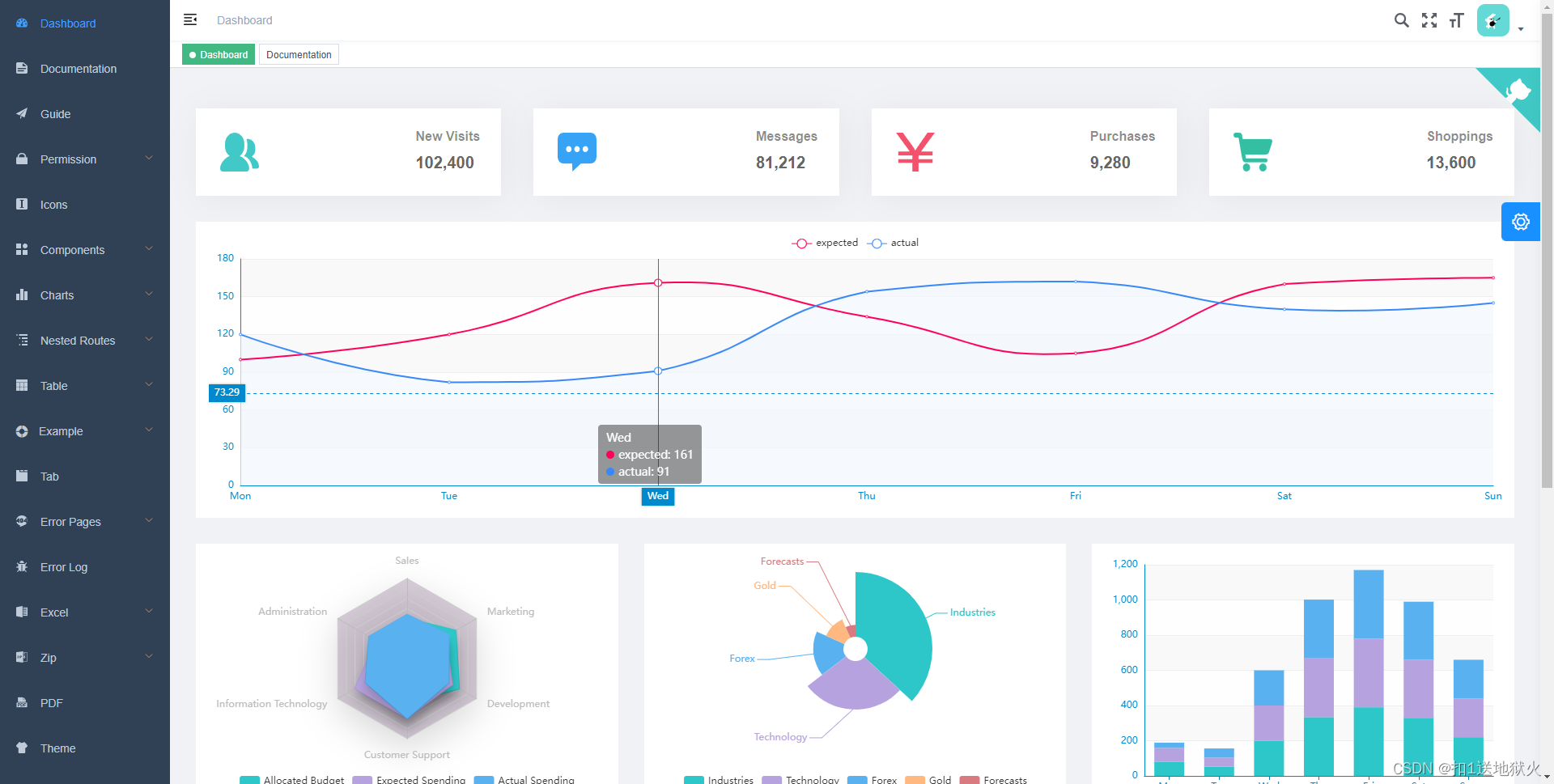
echarts
代码运行后第一眼就看见我前些天研究的图表,刚好项目是用的echarts,趁着还有些印象,先来研究一下Vue-element-admin是如何在项目中使用echarts的
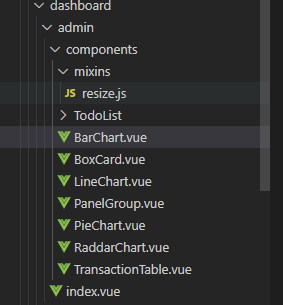
?看了几个图表后就得折线图比较符合我的思路就以折线图为例
src/views/dashboard/admin/components/LineChart.vue
先把代码复制下来逐行分析
<template>
<div
:class="className"
:style="{height:height,width:width}"
/>
</template>
<script>
//导入echarts 好像不是按需导入
import echarts from 'echarts'
require('echarts/theme/macarons') // echarts theme
import resize from './mixins/resize' //应该是封装的resize函数等下再看
export default {
mixins: [resize],//通过混合使用
props: {
//图表样式
className: {
type: String,
default: 'chart'
},
width: {
type: String,
default: '100%'
},
height: {
type: String,
default: '350px'
},
//不知道啥用 false 和true好像没区别
autoResize: {
type: Boolean,
default: true
},
//接收图表数据
chartData: {
type: Object,
required: true
}
},
data () {
return {
chart: null
}
},
//监听数据变化 如果发生改变就重新渲染图表
watch: {
chartData: {
deep: true,
handler (val) {
this.setOptions(val)
}
}
},
//创建图表
mounted () {
this.$nextTick(() => {
this.initChart()
})
},
// 销毁图表实例
beforeDestroy () {
if (!this.chart) {
return
}
this.chart.dispose()
this.chart = null
},
methods: {
// 初始化图表实例
initChart () {
//vm.$el获取Vue实例关联的DOM元素;
this.chart = echarts.init(this.$el, 'macarons')
this.setOptions(this.chartData)
},
// 接收图表数据进行渲染
setOptions ({ expectedData, actualData } = {}) {
this.chart.setOption({
xAxis: {
data: ['Mon', 'Tue', 'Wed', 'Thu', 'Fri', 'Sat', 'Sun'],
boundaryGap: false,
axisTick: {
show: false
}
},
grid: {
left: 10,
right: 10,
bottom: 20,
top: 30,
containLabel: true
},
tooltip: {
trigger: 'axis',
axisPointer: {
type: 'cross'
},
padding: [5, 10]
},
yAxis: {
axisTick: {
show: false
}
},
legend: {
data: ['expected', 'actual']
},
series: [{
name: 'expected', itemStyle: {
normal: {
color: '#FF005A',
lineStyle: {
color: '#FF005A',
width: 2
}
}
},
smooth: true,
type: 'line',
data: expectedData,
animationDuration: 2800,
animationEasing: 'cubicInOut'
},
{
name: 'actual',
smooth: true,
type: 'line',
itemStyle: {
normal: {
color: '#3888fa',
lineStyle: {
color: '#3888fa',
width: 2
},
areaStyle: {
color: '#f3f8ff'
}
}
},
data: actualData,
animationDuration: 2800,
animationEasing: 'quadraticOut'
}]
})
}
}
}
</script>
一路看下来没什么问题,只有?autoResize不知道是干什么的,看结构应该是在index.vue传入图表数据
index.vue
没有传入宽高,用的默认值
<el-row style="background:#fff;padding:16px 16px 0;margin-bottom:32px;">
<line-chart :chart-data="lineChartData" />
</el-row>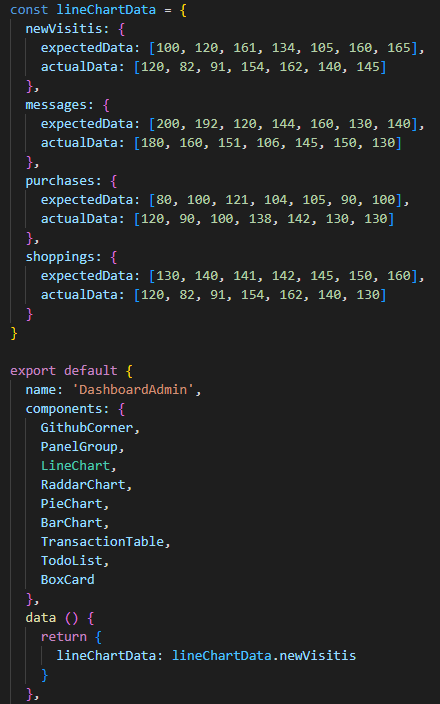
再看看resize.js,我水平不够还没有使用过mixins,正好借这个机会看看怎么使用
import { debounce } from '@/utils'//引入防抖函数等会来看
export default {
data () {
return {
$_sidebarElm: null,//字面意思是侧边栏,没太搞懂什么作用
$_resizeHandler: null
}
},
mounted () {
//定义resize事件 echart如果存在就会调用resize 让图表自适应显示
this.$_resizeHandler = debounce(() => {
if (this.chart) {
this.chart.resize()
}
}, 100)
// 窗口大小变化时就会resize保证图表显示正常
this.$_initResizeEvent()
//等会再研究
this.$_initSidebarResizeEvent()
},
//销毁上面两个函数
beforeDestroy () {
this.$_destroyResizeEvent()
this.$_destroySidebarResizeEvent()
},
//从其他组件切换到当前组件的时候,调用resize事件
activated () {
this.$_initResizeEvent()
this.$_initSidebarResizeEvent()
},
//切换到其他组件销毁上面两个方法
deactivated () {
this.$_destroyResizeEvent()
this.$_destroySidebarResizeEvent()
},
methods: {
$_initResizeEvent () {
window.addEventListener('resize', this.$_resizeHandler)
},
$_destroyResizeEvent () {
window.removeEventListener('resize', this.$_resizeHandler)
},
$_sidebarResizeHandler (e) {
if (e.propertyName === 'width') {//e.propertyName忘了是啥玩意,大概率是改变的属性啥的 等会查查
this.$_resizeHandler()
}
},
$_initSidebarResizeEvent () {
this.$_sidebarElm = document.getElementsByClassName('sidebar-container')[0]
//动画transition结束后调用this.$_sidebarResizeHandler
this.$_sidebarElm && this.$_sidebarElm.addEventListener('transitionend', this.$_sidebarResizeHandler)
},
$_destroySidebarResizeEvent () {
this.$_sidebarElm && this.$_sidebarElm.removeEventListener('transitionend', this.$_sidebarResizeHandler)
}
}
}
图表相关的都能看懂,就是sidebar相关的有点懵,e.propertyName也忘了,查了一下mdn好像有了点思路
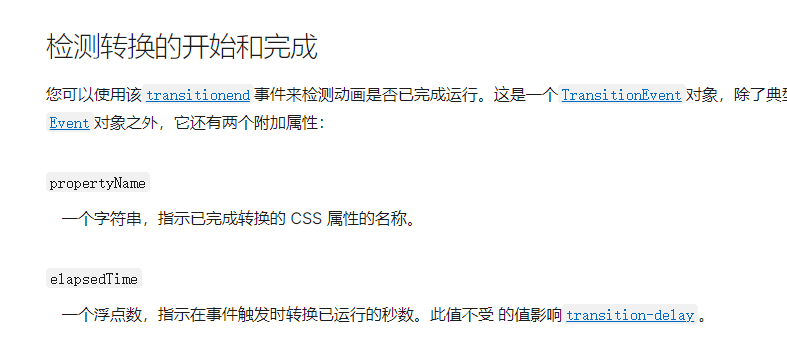
? 我猜测应该是侧边栏宽带发生变化时调用resize方法让图表正常显示
我这里操作了一下侧边栏可以变大变小,当宽带小到一定的时候侧边栏会消失
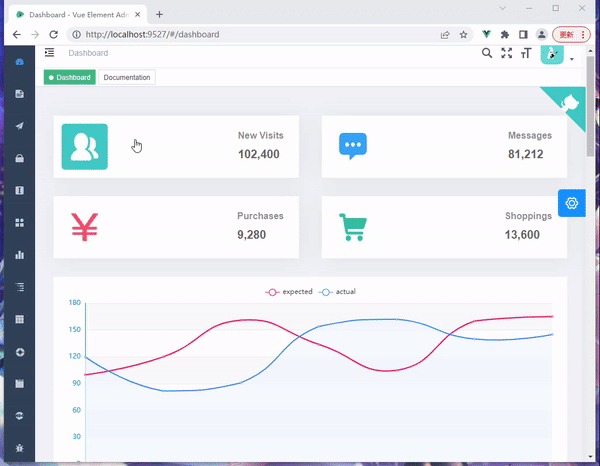
相关代码
$_sidebarResizeHandler (e) {
if (e.propertyName === 'width') {
this.$_resizeHandler()
}
$_initSidebarResizeEvent () {
this.$_sidebarElm = document.getElementsByClassName('sidebar-container')[0]
//动画transition结束后调用this.$_sidebarResizeHandler
this.$_sidebarElm && this.$_sidebarElm.addEventListener('transitionend', this.$_sidebarResizeHandler)
},最后我在
src/style/sidebar.css中证实了想法
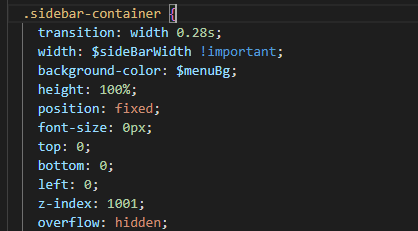
这样一来上面的代码就不难理解了?
通过e.propertyName指示完成动画的css属性名称,然后监听侧边栏的变化,如果是宽带发生改变,就对图表进行resize 保证正常显示
图表部分差不多就这些,用mixin 来处理 resize 代码确实是十分优雅,学到了
直接借鉴到自己的组件中
防抖函数
再分析一下防抖函数
好像和昨天刚看的underscore中防抖函数差不多的思想,有空我写一篇文章仔细分析一下
传入一个参数immediate,代表是否想要立即执行,如果传递了immediate,则立即执行一次函数,然后设置一个定时器,时间截止后将定时器设置为null,下次进入函数时先判断定时器是否为null,然后决定是否再次执行。
/**
* @param {Function} func
* @param {number} wait
* @param {boolean} immediate
* @return {*}
*/
export function debounce(func, wait, immediate) {
let timeout, args, context, timestamp, result
const later = function() {
// 据上一次触发时间间隔
const last = +new Date() - timestamp
// 上次被包装函数被调用时间间隔 last 小于设定时间间隔 wait
if (last < wait && last > 0) {
timeout = setTimeout(later, wait - last)
} else {
timeout = null
// 如果设定为immediate===true,因为开始边界已经调用过了此处无需调用
if (!immediate) {
result = func.apply(context, args)
if (!timeout) context = args = null
}
}
}
return function(...args) {
context = this
timestamp = +new Date()
const callNow = immediate && !timeout
// 如果延时不存在,重新设定延时
if (!timeout) timeout = setTimeout(later, wait)
if (callNow) {
// 如果定时器不存在并且传递了immediate,立即执行
result = func.apply(context, args)
context = args = null
}
return result
}
}未完待续